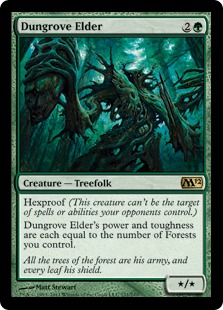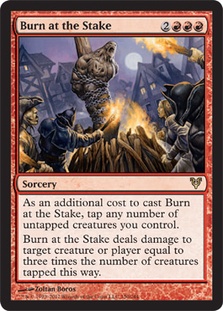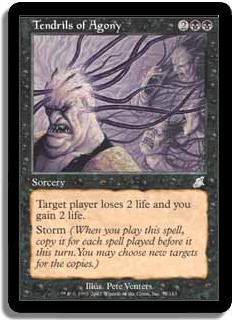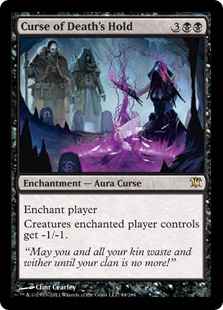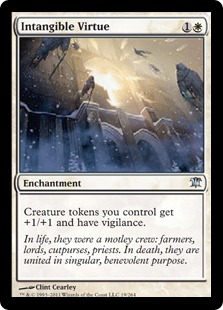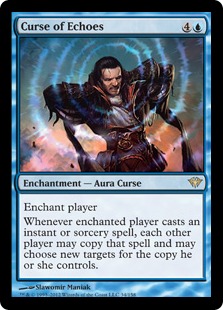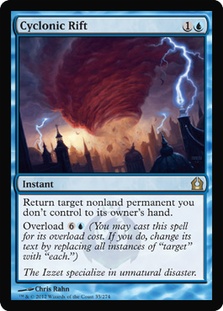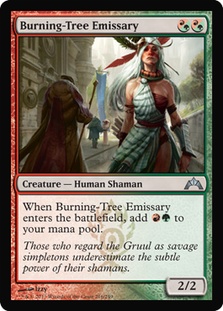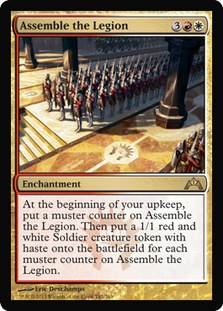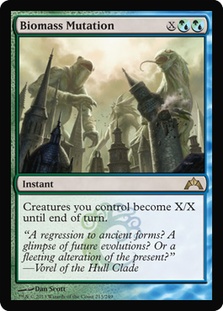Recently, I have been working on a few decks, one of which (believe it or not) is a mono-green deck for Modern, which looks like this:
Creatures (21)
- 4 Noble Hierarch
- 2 Arbor Elf
- 2 Thrun, the Last Troll
- 4 Dungrove Elder
- 4 Strangleroot Geist
- 4 Predator Ooze
- 1 Vorapede
Planeswalkers (3)
Lands (24)
Spells (12)
Sideboard

While actually performing quite well, the deck has several matchups that it basically just can’t win. So, while I am not completely done with the deck, there are currently more promising subjects to look into.
The second deck that I have been working on is another Modern deck. This one is based on the interaction between Academy Researchers and Eldrazi Conscription, as well as that between Arcanum Wings and Slippery Bogle / Gladecover Scout.
Creatures (11)
Lands (21)
Spells (28)
- 4 Sleight of Hand
- 4 Serum Visions
- 4 Arcanum Wings
- 1 Elder Mastery
- 4 Spell Pierce
- 3 Dispel
- 4 Eldrazi Conscription
- 4 Gitaxian Probe
Sideboard

The idea is pretty simple. Get an Eldrazi Conscription on the board (preferably enchanted to one of the hexproof creatures) and swing in. The combo is very powerful but is also very disruptable, whether by Inquisition or Thoughtseize or by Liliana of the Veil, Abrupt Decay, or Path to Exile. I think what the deck really needs is a more reliable Plan B than isn’t as easily beatable as Academy Researcher, and under normal circumstances I would be currently trying to figure out what that Plan B might be (pun intended). The problem, you see, is that something far more awesome has come up, something so great that I have basically been forced to drop everything else I have been doing so that I could start testing immediately.
This thing, good readers, is the advent of Storm in Standard.
Recently, I was on StarCityGames.com, minding my own business, when my eyes caught on a Versus video with Ali Aintrazi and Nick Spagnolo entitled "Ali vs. Nick: Burn At The Stake vs. Esper Control" This interested me quite a bit. I knew that AJ Kerrigan had tried out a Burn at the Stake deck before Return to Ravnica was released, but that was before rotation, so I was interested to see how the deck functioned without Scars of Mirrodin block. After watching Ali beat Nick in a solid 2-1 with the combo deck, I knew that I had to give it a shot. This is the deck I initially started testing with:
Creatures (8)
Lands (17)
Spells (31)

I made a few changes to Ali’s original 75. I did what he and Nick were discussing at the end of the video and cut one of the Past in Flames and the Shattered Perception, replacing them with two Infernal Plunge, which Ali had forgotten was in Standard. I also took out the two Bonfire of the Damned because I didn’t really feel they were what the deck wanted to bring in against aggressive matchups, preferring instead to just combo off and win. Maybe that was just flat out wrong. I can see how it would be nice to make a bunch of mana and Bonfire an unexpecting board, but I don’t know if it’s necessary. I also took out a Talrand, Sky Summoner and added two Talrand’s Invocation because I knew I wanted to try both but wasn’t sure which would go better in the deck.
Before I get into specifics, I should address the fact that this deck is, of course, not a real Storm deck. This is a real Storm deck:
Lands (13)
Spells (47)

The Storm archetype, for those who don’t know, is based on the mechanic of storm, which is a keyword on a spell that counts the number of spells already cast that turn and then copies the storm spell for the number of spells counted. Obviously, there are no storm cards in Standard, but Burn at the Stake comes incredibly close when paired with eight 1/1 tokens.
Getting to how the deck plays, my first impression was that this deck is very powerful. Putting the opponent from twenty to zero in one turn is an incredibly powerful thing for a deck to be doing. Because of this incredibly potent Plan A, this deck has a lot of free win potential, especially game 1, as most decks don’t have many counterspells or targeted hate cards like Golgari Charm, Curse of Death’s Hold, Rest in Peace, and the like until games 2 and 3. Wraths can be somewhat of a problem, but as long as you don’t overextend too much on any one turn, you can usually hold back enough that even if they cast a board wipe you can go off a turn or two later.
However, as much this deck does in game 1, it definitely has some failings in games 2 and 3. Obviously, this can’t be ignored because the majority of games in Magic are sideboarded games, so I knew after my first few matches that I had to make some changes. I’d tried boarding in Talrand’s Invocation and Talrand himself, but both of those cards are a bit slow and both cost double blue, which is not something the deck really wants to see a lot of. I decided to try putting two Intangible Virtue in the sideboard, as it counters Golgari Charm and Curse of Death’s Hold as well as makes cards like Bonfire of the Damned at least cost a little more.
It also allowed the deck to not have to overextend as much to kill with normal damage, which provides a more solid Plan B in games 2 and 3, where I found myself often in the need of killing with combat damage after, for example, my Burn at the Stakes were Slaughter Games’d. In fact, Intangible Virtue proved so great that I decided to put two in the maindeck, removing a Reforge the Soul and a Desperate Ravings, which sometimes hindered more than they helped. If you Reforge and fizzle, your opponent now has a brand-new hand filled with answers to your army of 1/1s, and it is not the best feeling either when Desperate Ravings discards your Burn at the Stake when you don’t have a Past in Flames on the turn your were planning on going off.
Looking at other cards in the list, one that was interesting to me in Ali’s list was Curse of Echoes. The idea is that you bring it in against decks that rely heavily on cards like Sphinx’s Revelation, and if they want to draw, you get to as well. It also has the unique effect of making all of your spells uncounterable except by Counterflux, which can be very useful when going off against a control deck. The problem is, however, that Curse of Echoes usually takes an entire turn to cast, one in which it is very possible that you would rather be building up to go off on the next. I haven’t totally counted it out, as I haven’t had the opportunity to fully maximize it in a game yet, but I did take one copy out of the board.
Another card that I am not totally sure about is Cyclonic Rift. Cyclonic Rift is a card that is very good at protecting the combo on paper, as it can do things like bounce a Rest in Peace or a Curse of Death’s Hold at the end of the opponent’s turn in order to allow the deck to go off on the following one. The problem that I have found with the card is not a negative one; it just doesn’t really feel necessary.
In terms of Curse of Death’s Hold, Intangible Virtue is a much more permanent answer that also actively adds to killing the opponent when a Curse is not on the board as well as shuts down Golgari Charm. When looking at graveyard hate like Rest in Peace and Grafdigger’s Cage, the majority of the damage done by Rest in Peace happens the turn it comes down. Also, I have found in testing that the deck can often go off without the graveyard as a resource at all because really all the deck needs to kill is six to seven creatures, depending on the opponent’s life total, and a Burn at the Stake. I could see the effect of Cyclonic Rift against Grafdigger’s Cage, though, as it leaves cards in their respective graveyards.
Here is the list as I have it now. I plan on continuing to test it and change card numbers around, but this is where I am at the moment:
Creatures (8)
Lands (21)
Spells (31)

In summation, I absolutely love saying "summation." All terrible jokes aside, though, this deck is actually good, and I feel as though it is a very reasonable choice for the current metagame. It has a lot of free win potential game 1, and while there is a lot of hate for it in the field as it stands, there are a lot of ways this deck has to answer that hate. Before I recommend this deck, however, I need to offer a warning. This deck is incredibly hard to play. The first several matches I played I lost because of mistakes that can only really be avoided through practice. I have lost multiple games because I didn’t tap the right land and so didn’t have the correct color open for the card that I needed to draw. All I can say is practice. Practice, practice, practice.
Before I go, I want to say a quick word about cards from Gatecrash that could possibly work in this deck. Burning-Tree Emissary is interesting just as a free creature that can tap for Burn at the Stake, but since it doesn’t give card advantage in any way, I don’t know if it will find a place here. I am much more interested in seeing if Assemble the Legion is too slow, as if it proves not to be it seems as though it would be a house against mass removal.
I am also very interested in Biomass Mutation since casting a big Mutation could be exactly what this deck needs as a second combo piece in case Burn at the Stake gets Slaughter Games’d. It could be hard to cast though due to the fact that once you make a lot of mana with this deck you are usually left with only red mana, which obviously can’t cast a double blue spell. Anyway, I’m rambling. Hope you enjoyed my first article!
Thanks for reading!
–Eric

